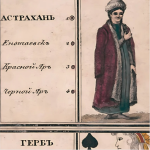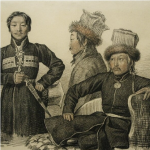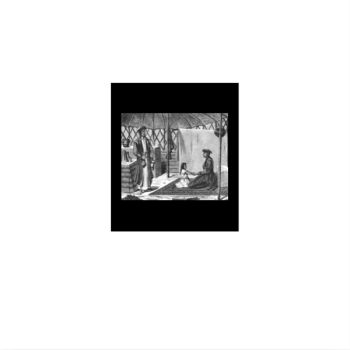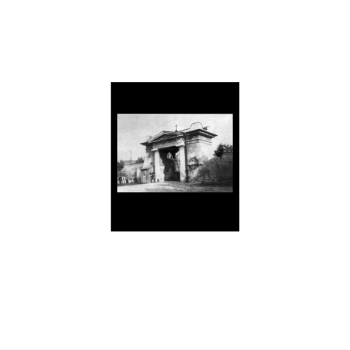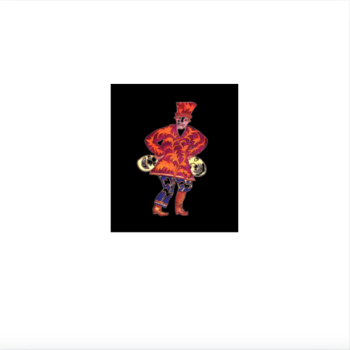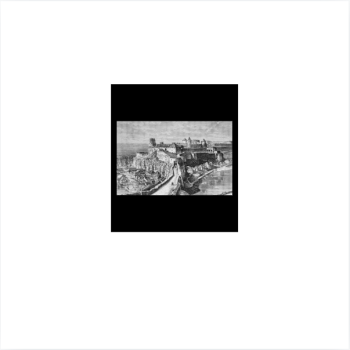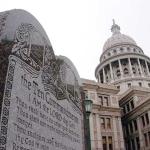NEVSKY PROSPEKT
July 1836
The Hahn family left Ekaterinoslav on April 30th for Karachev (Oryol Province,) Pyotr Alekseevich having been transferred to the 3rd Cavalry Artillery Division. When they arrived, they found the battery had gone to Voronezh. So, on May 24, they went to Voronezh. There was another change in plans. The Battery was now in Stary Oskol, so the family continued to Stary Oskol. On the 4th day of their arrival, Pyotr Alekseevich was asked to go to St. Petersburg to command a model battery for a test of service. Pyotr Alekseevich was not terribly pleased with this arrangement, as he did not want to live in Russia. All the moving about (and the road ahead to St. Petersburg) had greatly expanded his finances and living with the family in the capital would be very expensive.[1] Nevertheless, they arrived in the third week of July.
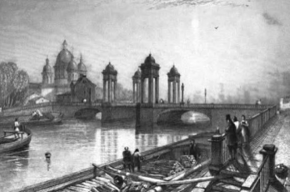
Troitsky Bridge.[2]
After four years of enduring humiliation under the shadow of army judgments and condemnations, it was a welcomed change of pace. Like a prisoner released from a long jail sentence, she was ready to wander the streets all day long, admiring the setting sun at the palace pier, the picture of the Neva, covered with lumber. That first night the whole city—from the Smolny Monastery to the seaside—was like a magical panorama. On one side was the wide, quiet Neva with a whole forest of masts and sails on her water. On the other side, there were palaces, embankments, and gardens. All of it drowned in a golden fog sunset. Her motto for the first few months was “to see everything and have nothing.”
One thing was not good—there was no one to explore with. Petersburg was nothing new for Pyotr Alekseevich, having spent his childhood and youth there. The metropolitan laws at the time did not make it easy for her to walk alone. Only after becoming acquainted with her husband’s relatives and his brothers did she find a constant companion in the person of Ivan Alekseevich, who, like her, was a passionate lover of nature, art, and everything elegant. They got along swimmingly, and Helena Andreevna referred to him affectionately as “Jean” (the French version of Ivan.) With him, she visited cathedrals and art shops (that replaced the traveling exhibitions.) They walked along Petersburg’s main boulevard, Nevsky Prospekt, the street which Gogol (who just left Petersburg for Western Europe) called the city’s “very life-blood”[3] The street was “lined with thick linden trees” on both sides, but beginning in the 1830s, the thoroughfare came exemplify the burgeoning eclectic trend in Russian architecture.[4] She sailed with “Jean” on a longboat along the canals and admired the view from Peter and Paul Fortress. “The picture is the only one to paint, and for an hour it ran from one side to the other,” she would write. “Yes, I admired it, and under my feet, under this rampart, in the damp earth, thousands of unfortunates lived, and lived there still—casket-mates.”
A deeply religious and enthusiastic patriot, Helena Andreevna was awestruck by the grandeur of the shrines and victory trophies inside the churches. At the end of an avenue of birch trees was the namesake of the boulevard, the Nevsky Monastery, a large pile of buildings painted white with green roofs. The principal attraction was the large cathedral that contained the shrine of Alexander Nevsky (an imperial and warrior saint who was Tsar of Muscovy.) It was an immense silver monument, several yards in height, and placed against the wall. In the front was a sarcophagus of the same metal on a raised dais; on its cover was a full-length likeness of the dead, crowned by a halo of radiant glory in pure gold. At the head of the tomb was a beautiful silver lamp that was always kept burning, and which cast down on the features a soft light. At the foot of the shrine were seated two large figures of angels in silver, and at each side of it was a military trophy consisting of shields, spears, and battleaxes, all of the same precious metal.[5]
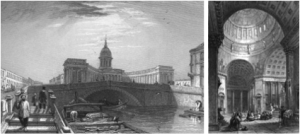
(Left) Kazan Cathedral Exterior. (Right) Kazan Cathedral Interior.[6]
Nothing, however, could compare with the deep impression that took possession of her upon entering the massive Kazan Cathedral. Having entered this wonderful temple, the only thing that kept her from throwing herself on her knees at the glory of Russia, was the presence of Ivan Alekseevich. Both sides of the cathedral were covered with bouquets of banners captured from enemies during the reigns of Tsars Alexander and Nicholas. Below the banners were inscriptions written on a gold board describing when they were captured, by whom, and from whom. “Oh, how the famous Napoleonic eagles look dejectedly here! Hanging their noses sadly, they seem ready to hide their shameful heads under their wings!” Helena Andreevna thought. “Here is the Persian lion, humbled into a lamb!”
She stood, one day, for a long time near the Winter Palace, admiring the stormy Neva and the sunset between the black clouds. On the opposite bank, rose the brightly gilded spitz of the fortress. Waves crashed by the colonnade near the trenches and fortress walls, with steamboats puffing fantastically-colored plumes of smoke. “How can one not admire such a picture?” she thought.
A big obstacle in the lonely walks of a pretty young lady through the streets of the capital were the “street ladies’ men” (a clientele unknown in the provinces.) The old man followed her for a long time, talking to her and showering her with compliments in three languages (Russian, French, and German) and she quickly got tired of him. She decided to get away by pretending that she did not understand what he was saying. Turning around, she shouted angrily:
“Lasciami, signor! Non so che dice!”
“Ah! Italian!” he said through his teeth. “I can’t talk to you!”
At the turn, he disappeared.
In the evening Ivan Alekseevich and Nikolai Vasilchikov (Pyotr and Ivan’s stepfather) came and frightened her so much with stories about similar street adventures (very unpleasant) that she decided not to go on lonely walks anymore.
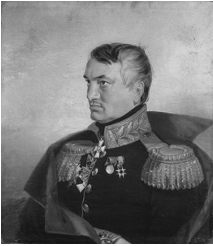
Nikolay Vasilyevich Vasilchikov.
An incident of a similar kind happened to Helena Andreevna a few days later. Though it ended comically, it further convinced her of the danger a pretty young woman faced when walking late on the streets of St. Petersburg. She was returning from an all-night vigil at church, not far from home, when a very young officer approached with an offer to accompany her.
Looking more closely at his epaulets, she saw that he was an artilleryman, and not only that, but he also belonged to the same battery as Pyotr Alekseevich. She immediately plotted a scheme and decided to give him a useful lesson. He enthusiastically suggested walks, dinners, restaurants, and pastry shops.
“All of this is unnecessary,” said Helena Andreevna, cheekily. “It would be much easier and more fun if you took me to my apartment.”
“Do you live alone?” he asked.
“No, not alone…but my friends will be very glad to see you!” said Helena Andreevna reassuringly as they entered the gate. “I live here! I ask you to follow me.”
The officer, beside himself with joy, entered in the heat of the moment, not making out the uniform on the front coatrack. His hospitable companion made sure to wait until he took off his outer dress and, accompanied by him, entered the living room, where Pyotr Alekseevich was sitting, calmly smoking a pipe and playing patience (solitaire.)
“Pyotr Alekseevich,” said Helena Andreevna, “here is a young man, your colleague! He escorted me out of the church. Thanks to him, I didn’t have to walk alone at night!”
One can imagine the pitiful situation of the officer, who was planning to spread his inexperienced wings for the first time! Taken aback, he turned pale seeing his direct superior in front of him (there was nothing, however, fear-inspiring in Pyotr Alekseevich’s good-natured reception.) Despite strenuous requests to stay and drink tea, the young artilleryman, who turned out to be a warrant officer who just graduated from school, embarrassedly refused to spend the evening in present company. He could not look into Helena Andreevna’s eyes during meetings, although she, with her friendly, even manner, never reminded him of his awkward mistake, over which, after he left, she and Pyotr Alekseevich had a good laugh.[7]
-
- NOVOROSSIYA
- The Arbiter Of Europe’s Destiny.
- The House Dolgorukuy
- Madame Krüdener
- Ekaterinoslav
- The Arabat Arrow
- The Mystery Of General Inzov
- The Doukhobors
- Pushkin
- Chuguev Military Settlement
- “The Blessed”
- The Decembrists
- Penza
- Independence
- Last Words Of Samuel Khristianovich Kontenius
- “Amid Coffins And Desolation”
- Rusalka
- Dead Souls
- Secret Passages
- Astrakhan
- Nevsky Prospekt
- Kalmyk Ulus
- Love And Ambition
- Duellistes
- Pyatigorsk
- A Heroine Of Our Time
- Winter Palace
- Zeneida R-Va
- Steppes
- Letter To Natalya
- Fire And Ice
SOURCES:
[1] “Letters From P. A. Hahn To G. V. Nechaev.” Letter 1. Dated June 5, 1836. [Stary Oskol.] [Bahmut Roerich Center.]
[2] Ritchie, Leitch. A Journey To St. Petersburg And Moscow Through Courland And Livonia. Longman, Rees, Orme, Brown. Green, And Longman. London, England. (1836): 47.
[3] Gogol, Nikolay. (tr.) Wilks, Ronald. Diary Of A Madman, The Government Inspector, And Selected Stories. Penguin Books. London, England. (2005): viii, 78. (“Nevsky Prospekt” 78-112.)
[4] Buckler, Julie A. Mapping St. Petersburg: Imperial Text And Cityshape. Princeton University Press. Princeton, New Jersey. (2007): 78.
[5] Montefiore, Judith Cohen. The Englishwoman In Russia. John Murray. London, England. (1855): 75-77.
[6] Ritchie, Leitch. A Journey To St. Petersburg And Moscow Through Courland And Livonia. Longman, Rees, Orme, Brown. Green, And Longman. London, England. (1836): 98, 100.
[7] Nekrasova, E. S. “Helena Andreyevna Hahn (1814-1842): Part I.” Russkaia Starina. Vol. LI, No. 8 (August 1886): 335-354; Zhelikhovskaya, Vera Petrovna. “Helena Andreyevna Hahn (1835-1842.)” Russkaia Starina. Vol. LII, No. 3 (March 1887): 733-766.


